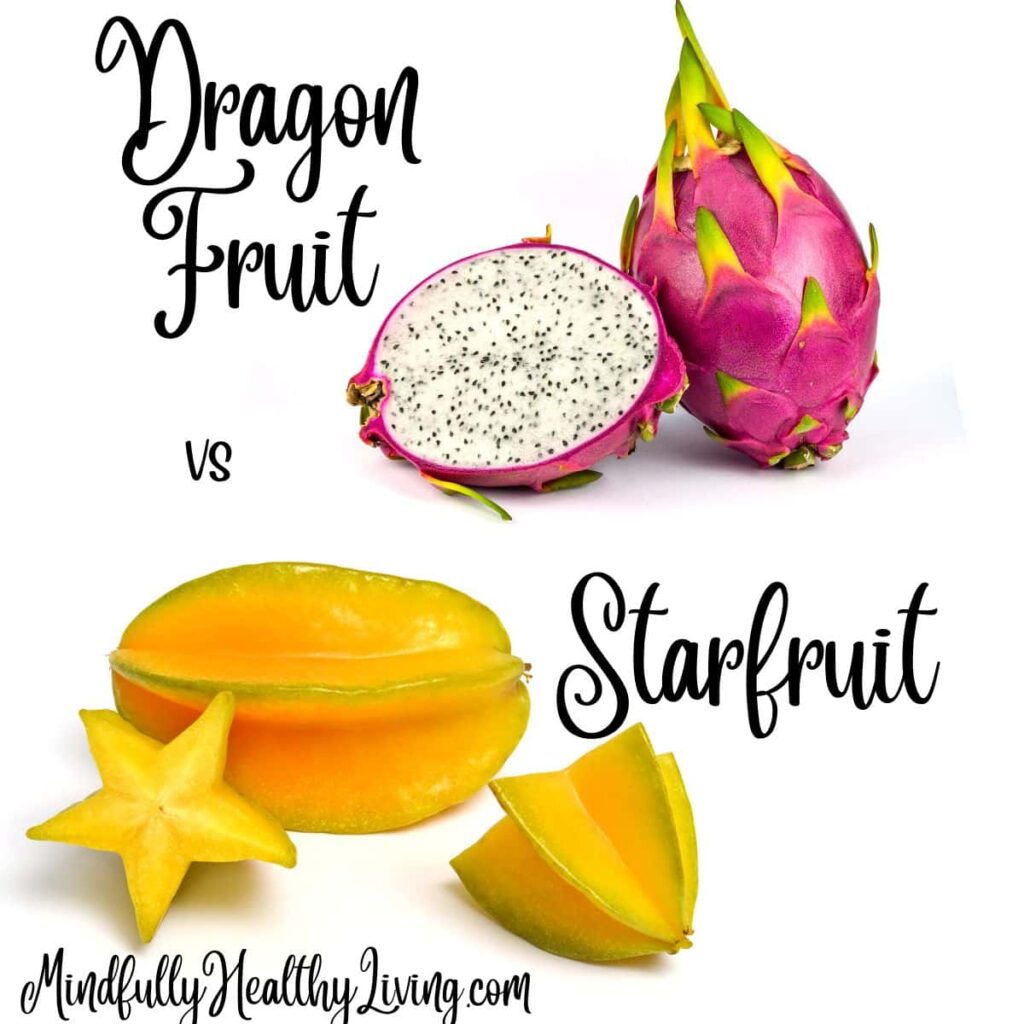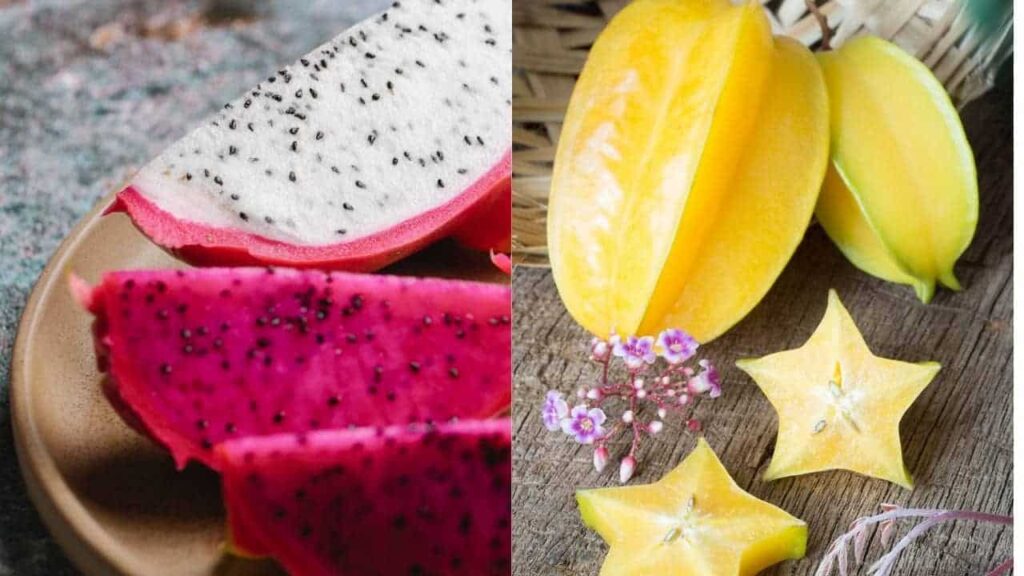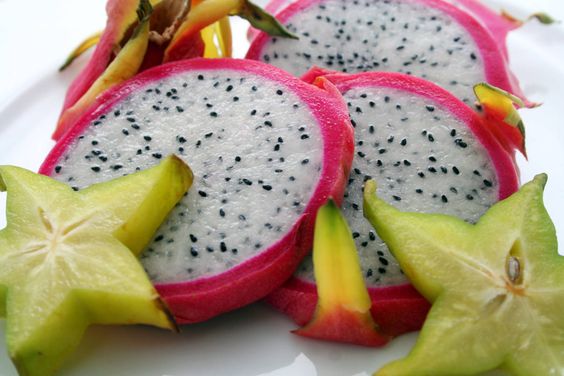Starfruit vs. dragon fruit: star fruit (carambola), and dragon fruit (pitaya) are two distinct tropical fruits, each with unique characteristics in terms of appearance, flavor, nutritional content, and cultivation. Let’s explore the differences between star fruit and dragon fruit:
Table of Contents
Starfruit Vs. dragon fruit

Appearance:
Star Fruit (Carambola):
Shape: Star fruit is typically elongated and has a distinctive five-pointed star shape when sliced crosswise.
Color: The skin of star fruit is usually yellow or green, and the flesh is translucent with a juicy texture.
Dragon Fruit (Pitaya):
Shape: Dragon fruit is generally round or oval, with a leathery, bright-colored outer skin covered in scales or spikes.
Color: The flesh of dragon fruit comes in various colors, including white, red, or pink. The outer skin may be yellow, pink, or red, depending on the variety.
Flavor:
Star Fruit (Carambola):
Taste: Star fruit has a sweet and slightly tangy flavor. The taste can vary from mildly sweet to more tart, depending on the ripeness.
Dragon Fruit (Pitaya):
Taste: Dragon fruit has a mild, subtly sweet taste with a texture akin to kiwi or pear. The flavor is delicate, and the seeds in the flesh add a slight crunch.

Nutritional Content:
Star Fruit (Carambola):
Nutrients: Star fruit is a good source of vitamin C, fiber, and antioxidants. It also contains small amounts of vitamins and minerals like potassium.
Dragon Fruit (Pitaya):
Nutrients: Dragon fruit is rich in vitamin C, fiber, antioxidants, and several minerals. It’s notably lower in calories and has a high water content, making it a hydrating choice.
Varieties and Cultivation:
Star Fruit (Carambola):
Varieties: Common varieties include the sweet and tart types, such as the Golden Star and the Sri Kembangan.
Cultivation: Star fruit is grown in tropical regions and thrives in warm, humid climates.
Dragon Fruit (Pitaya):
Varieties: There are several varieties of dragon fruit, with the most common being the red and white varieties.
Cultivation: Dragon fruit cactus plants thrive in arid or semi-arid conditions and are cultivated in countries with a tropical or subtropical climates.

Culinary Uses:
Star Fruit (Carambola):
Culinary Applications: Star fruit is often consumed fresh, sliced, and added to fruit salads, or used as a garnish. It can also be juiced or incorporated into desserts and beverages.
Dragon Fruit (Pitaya):
Culinary Applications: Dragon fruit is commonly eaten fresh, either on its own or added to fruit salads and smoothie bowls. Its vibrant appearance makes it a popular choice for decorative purposes in dishes and beverages.
In summary, while both star fruit and dragon fruit are exotic tropical fruits with unique characteristics, their differences lie in their appearance, flavor profile, nutritional content, and culinary applications. Whether enjoyed on their own or as part of creative culinary creations, both fruits bring a touch of tropical allure to the table.
FAQ’s
Is starfruit the same as dragon fruit?
No, starfruit (carambola) is not the same as dragon fruit (pitaya). They are two distinct tropical fruits with different appearances, flavors, and nutritional profiles. Starfruit has a star-like shape when sliced crosswise, and its taste is sweet and slightly tangy. Dragon fruit, on the other hand, has a round or oval shape with vibrant outer skin and a mildly sweet taste, often compared to a blend of kiwi and pear.
Which fruit is equal to dragon fruit?
While no fruit is an exact equivalent to dragon fruit in terms of appearance and taste, some fruits share similar qualities. Pitahaya, commonly known as dragon fruit, is often compared to kiwi and pear due to its mildly sweet flavor and crunchy texture.
Can you eat star fruit raw?
Yes, star fruit can be eaten raw. In fact, it is commonly consumed fresh. The skin is edible, and the fruit can be sliced and added to fruit salads, eaten on its own, or used as a garnish. However, some individuals with kidney issues are advised to limit their consumption of star fruit, as it contains oxalic acid, which can be harmful to those with certain renal conditions.
Is dragon fruit better than other fruits?
The nutritional value of fruits varies, and what makes a fruit “better” depends on individual dietary needs and preferences. Dragon fruit is a nutritious option, rich in vitamin C, fiber, antioxidants, and minerals. It is low in calories and has a high water content, making it a hydrating choice. However, no single fruit can provide all the nutrients the body needs, so a diverse intake of fruits is recommended to ensure a well-rounded diet.
